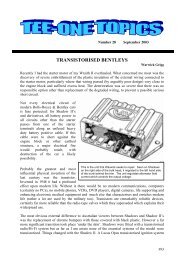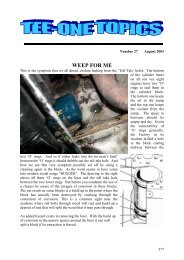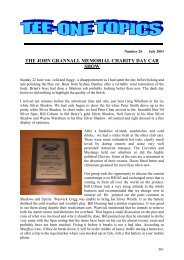Issue21 Feb03 - Rolls Royce & Bentley Owners Club - South Africa
Issue21 Feb03 - Rolls Royce & Bentley Owners Club - South Africa
Issue21 Feb03 - Rolls Royce & Bentley Owners Club - South Africa
Create successful ePaper yourself
Turn your PDF publications into a flip-book with our unique Google optimized e-Paper software.
are full the control valves allow the output from the pump to return to the reservoir. The<br />
pressures being handled here are of the order of 2,500 lbs/sq/in.<br />
The Brake Actuators<br />
These are the ‘taps’ referred to previously. The spin merchants promote the name ‘rat trap’ to<br />
describe this fascinating mechanism. Located under the driver the assembly consists of two<br />
valves, one for each braking system, a device for reducing the pressure to the back wheels to<br />
minimise rear wheel skidding under heavy braking, a switch to operate the stop lights and in<br />
cars made in 1975 and earlier, a small master cylinder to give the driver some feel to the pedal.<br />
The Accumulators<br />
These consist of two hemispheres held together by a screwed ring. Sandwiched between them is<br />
a very thick flexible diaphragm. The top of the accumulator screws into the control valve and<br />
receives the oil through a port. The bottom of the accumulator has a charging point with a non<br />
return valve that allows nitrogen to be forced into the lower half of the vessel.<br />
Nitrogen is passed into the accumulator upon initial assembly forcing the diaphram to the top of<br />
the sphere. The pressure installed is 1000 psi. It is this pressure that applies your brakes. As<br />
the oil is pumped in the diaphragm is forced down and the nitrogen further compressed. When<br />
the<br />
This is the setup for pre-Shadow II’s with both<br />
accumulators on the left hand rear side of the<br />
engine. Access for re-charging is reasonable<br />
although the rear unit can be a bit close!<br />
maximum operating pressure<br />
approximately 2,600 psi is reached the<br />
regulator cuts off the oil input and the<br />
charged sphere waits until there is a<br />
demand for the application of brakes or<br />
the extention of the rams to lift the rear<br />
of the car.<br />
Maintenance<br />
Apart from checking that the brake light<br />
switches are working and changing the<br />
oil regularly, no other maintenance is<br />
required. The failure of the units is<br />
invariably the depletion of the nitrogen<br />
charge. This presumably leaks out<br />
through and around the diaphragm. The<br />
indicator is the number of pumps you<br />
can subject a fully pumped up<br />
accumulator to stand before the brake<br />
288






